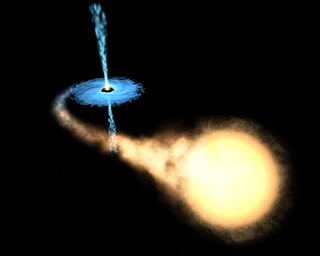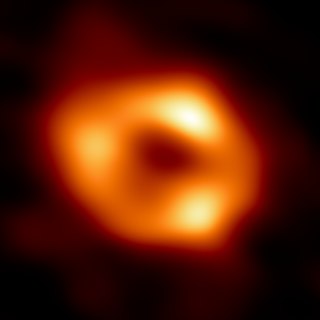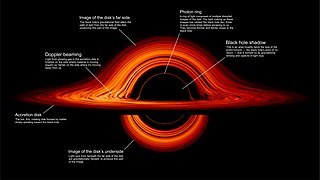Related Research Articles

Star formation is the process by which dense regions within molecular clouds in interstellar space, sometimes referred to as "stellar nurseries" or "star-forming regions", collapse and form stars. As a branch of astronomy, star formation includes the study of the interstellar medium (ISM) and giant molecular clouds (GMC) as precursors to the star formation process, and the study of protostars and young stellar objects as its immediate products. It is closely related to planet formation, another branch of astronomy. Star formation theory, as well as accounting for the formation of a single star, must also account for the statistics of binary stars and the initial mass function. Most stars do not form in isolation but as part of a group of stars referred as star clusters or stellar associations.

X-ray binaries are a class of binary stars that are luminous in X-rays. The X-rays are produced by matter falling from one component, called the donor, to the other component, called the accretor, which is either a neutron star or black hole. The infalling matter releases gravitational potential energy, up to 30 percent of its rest mass, as X-rays. The lifetime and the mass-transfer rate in an X-ray binary depends on the evolutionary status of the donor star, the mass ratio between the stellar components, and their orbital separation.

A microquasar, the smaller version of a quasar, is a compact region surrounding a stellar black hole with a mass several times that of its companion star. The matter being pulled from the companion star forms an accretion disk around the black hole. This accretion disk may become so hot, due to friction, that it begins to emit X-rays. The disk also projects narrow streams or "jets" of subatomic particles at near-light speed, generating a strong radio wave emission.
The Eddington luminosity, also referred to as the Eddington limit, is the maximum luminosity a body can achieve when there is balance between the force of radiation acting outward and the gravitational force acting inward. The state of balance is called hydrostatic equilibrium. When a star exceeds the Eddington luminosity, it will initiate a very intense radiation-driven stellar wind from its outer layers. Since most massive stars have luminosities far below the Eddington luminosity, their winds are mostly driven by the less intense line absorption. The Eddington limit is invoked to explain the observed luminosity of accreting black holes such as quasars.

Messier 87 is a supergiant elliptical galaxy in the constellation Virgo that contains several trillion stars. One of the largest and most massive galaxies in the local universe, it has a large population of globular clusters—about 15,000 compared with the 150–200 orbiting the Milky Way—and a jet of energetic plasma that originates at the core and extends at least 1,500 parsecs, traveling at a relativistic speed. It is one of the brightest radio sources in the sky and a popular target for both amateur and professional astronomers.

A supermassive black hole is the largest type of black hole, with its mass being on the order of hundreds of thousands, or millions to billions, of times the mass of the Sun (M☉). Black holes are a class of astronomical objects that have undergone gravitational collapse, leaving behind spheroidal regions of space from which nothing can escape, not even light. Observational evidence indicates that almost every large galaxy has a supermassive black hole at its center. For example, the Milky Way galaxy has a supermassive black hole at its center, corresponding to the radio source Sagittarius A*. Accretion of interstellar gas onto supermassive black holes is the process responsible for powering active galactic nuclei (AGNs) and quasars.

A stellar black hole is a black hole formed by the gravitational collapse of a star. They have masses ranging from about 5 to several tens of solar masses. The process is observed as a hypernova explosion or as a gamma ray burst. These black holes are also referred to as collapsars.

Sagittarius A*, abbreviated Sgr A*, is the supermassive black hole at the Galactic Center of the Milky Way. Viewed from Earth, it is located near the border of the constellations Sagittarius and Scorpius, about 5.6° south of the ecliptic, visually close to the Butterfly Cluster (M6) and Lambda Scorpii.

An astrophysical jet is an astronomical phenomenon where outflows of ionised matter are emitted as extended beams along the axis of rotation. When this greatly accelerated matter in the beam approaches the speed of light, astrophysical jets become relativistic jets as they show effects from special relativity.
Cygnus X-3 is a high-mass X-ray binary (HMXB), one of the stronger binary X-ray sources in the sky. It is often considered to be a microquasar, and it is believed to be a compact object in a binary system which is pulling in a stream of gas from an ordinary star companion. It is one of only two known HMXBs containing a Wolf–Rayet star. It is invisible visually, but can be observed at radio, infrared, X-ray, and gamma-ray wavelengths.
In astronomy, the intracluster medium (ICM) is the superheated plasma that permeates a galaxy cluster. The gas consists mainly of ionized hydrogen and helium and accounts for most of the baryonic material in galaxy clusters. The ICM is heated to temperatures on the order of 10 to 100 megakelvins, emitting strong X-ray radiation.
The gamma-ray and X-ray source GRS 1124-683, discovered by the Granat mission and Ginga, is a system containing a black hole candidate. The system also goes by the name X-ray Nova Muscae 1991 or GU Muscae. These two orbiting X-ray telescopes discovered the system when the system produced an outburst of X-rays on January 9, 1991.

GRS 1915+105 or V1487 Aquilae is an X-ray binary star system which features a regular star and a black hole. It was discovered on August 15, 1992 by the WATCH all-sky monitor aboard Granat. "GRS" stands for "GRANAT source", "1915" is the right ascension and "105" reflects the approximate declination. The near-infrared counterpart was confirmed by spectroscopic observations. The binary system lies 11,000 parsecs away in Aquila. GRS 1915+105 is the heaviest of the stellar black holes so far known in the Milky Way Galaxy, with 10 to 18 times the mass of the Sun. It is also a microquasar, and it appears that the black hole rotates at least 950 times per second, close to the maximum of 1,150 times per second, with a spin parameter value between 0.82 and 1.00.

The International Astrophysical Observatory "GRANAT", was a Soviet space observatory developed in collaboration with France, Denmark and Bulgaria. It was launched on 1 December 1989 aboard a Proton rocket and placed in a highly eccentric four-day orbit, of which three were devoted to observations. It operated for almost nine years.
The galactic ridge is a region of the inner galaxy that is coincident with the galactic plane of the Milky Way. It can be seen from Earth as a band of stars which is interrupted by 'dust lanes'. In these 'dust lanes' the dust in the gaseous galactic disk blocks the visible light of the background stars. Due to this, many of the most interesting features of the Milky Way can only be viewed in X-rays. Along with the point X-ray sources which populate the Milky Way, an apparently diffuse X-ray emission concentrated in the galactic plane is also observed. This is known as the galactic ridge X-ray emission (GRXE). These emissions were originally discovered by Diana Worrall and collaborators in 1982, and since then the origins of these emissions have puzzled astrophysicists around the globe.

An accretion disk is a structure formed by diffuse material in orbital motion around a massive central body. The central body is most frequently a star. Friction, uneven irradiance, magnetohydrodynamic effects, and other forces induce instabilities causing orbiting material in the disk to spiral inward toward the central body. Gravitational and frictional forces compress and raise the temperature of the material, causing the emission of electromagnetic radiation. The frequency range of that radiation depends on the central object's mass. Accretion disks of young stars and protostars radiate in the infrared; those around neutron stars and black holes in the X-ray part of the spectrum. The study of oscillation modes in accretion disks is referred to as diskoseismology.
Laura A. Lopez is an associate professor of astronomy at Ohio State University studying the life cycle of stars. She was awarded the Annie Jump Cannon Award in Astronomy in 2016, which is awarded by the American Astronomical Society (AAS) for outstanding research and promise for future research by a postdoctoral woman researcher.

NGC 708 is an elliptical galaxy located 240 million light-years away in the constellation Andromeda and was discovered by astronomer William Herschel on September 21, 1786. It is classified as a cD galaxy and is the brightest member of Abell 262. NGC 708 is a weak FR I radio galaxy and is also classified as a type 2 Seyfert galaxy.
References
- 1 2 "NAME Great Annihilator". SIMBAD . Centre de données astronomiques de Strasbourg.
- 1 2 3 4 Luque-Escamilla, Pedro L.; Martí, Josep; Martínez-Aroza, José (2015-12-01). "The precessing jets of 1E 1740.7−2942". Astronomy & Astrophysics. 584: A122. arXiv: 1511.01425 . doi: 10.1051/0004-6361/201527238 . ISSN 0004-6361.
- ↑ Sunyaev, R. A.; Borozdin, K. N.; Aleksandrovich, N. L.; Arefev, V. A.; Kaniovskii, A. S.; Efremov, V. V.; Maisack, M.; Reppin, C.; Skinner, J. K. (November 1994). "Observations of X-ray novae in Vela (1993), Ophiuchus (1993), and Perseus (1992) using the instruments of the Mir-Kvant module". Astronomy Letters. 20 (6): 777. Bibcode:1994AstL...20..777S.
- ↑ Odenwald, Sten (1997). "What do we know about the 'Great Annihilator' in the center of the Milky Way?". Astronomy Cafe. Archived from the original on 16 January 2013. Retrieved 4 August 2014.
- ↑ Mirabel, I. F. "The Great Annihilator in the Central Region of the Galaxy" (PDF). eso.org. pp. 51–54.
- ↑ Stecchini, Paulo Eduardo; Castro, Manuel; Jablonski, Francisco; D’Amico, Flavio; Braga, João (2017-06-30). "Tandem Swift and INTEGRAL Data to Revisit the Orbital and Superorbital Periods of 1E 1740.7–2942". The Astrophysical Journal. 843 (1): L10. arXiv: 1707.00730 . Bibcode:2017ApJ...843L..10S. doi: 10.3847/2041-8213/aa7942 . ISSN 2041-8213. S2CID 119354178.
- ↑ Hertz, P.; Grindlay, J. E. (1984-03-01). "The Einstein galactic plane survey : statistical analysis of the complete X-ray sample". The Astrophysical Journal. 278: 137–149. Bibcode:1984ApJ...278..137H. doi:10.1086/161775. ISSN 0004-637X.
- 1 2 Sunyaev, R.; Churazov, E.; Gilfanov, M.; Pavlinsky, M.; Grebenev, S.; Babalyan, G.; Dekhanov, I.; Khavenson, N.; Bouchet, L.; Mandrou, P.; Roques, J. P. (December 1991). "Three spectral states of 1E 1740.7-2942 – From standard Cygnus X-1 type spectrum to the evidence of electron-positron annihilation feature". The Astrophysical Journal. 383: L49. Bibcode:1991ApJ...383L..49S. doi: 10.1086/186238 . ISSN 0004-637X.
- ↑ Bouchet, L.; Mandrou, P.; Roques, J. P.; Vedrenne, G.; Cordier, B.; Goldwurm, A.; Lebrun, F.; Paul, J.; Sunyaev, R.; Churazov, E.; Gilfanov, M. (December 1991). "Sigma discovery of variable e(+)–e(−) annihilation radiation from the near Galactic center variable compact source 1E 1740.7-2942". The Astrophysical Journal. 383: L45. doi:10.1086/186237. ISSN 0004-637X.
- ↑ "Milky Way Monster". Time. 1992-07-27. ISSN 0040-781X . Retrieved 2019-10-24.
- ↑ Mirabel, I. F.; Rodríguez, L. F.; Cordier, B.; Paul, J.; Lebrun, F. (July 1992). "A double-sided radio jet from the compact Galactic Centre annihilator 1E1740.7–2942". Nature. 358 (6383): 215–217. Bibcode:1992Natur.358..215M. doi:10.1038/358215a0. ISSN 0028-0836. S2CID 4264588.